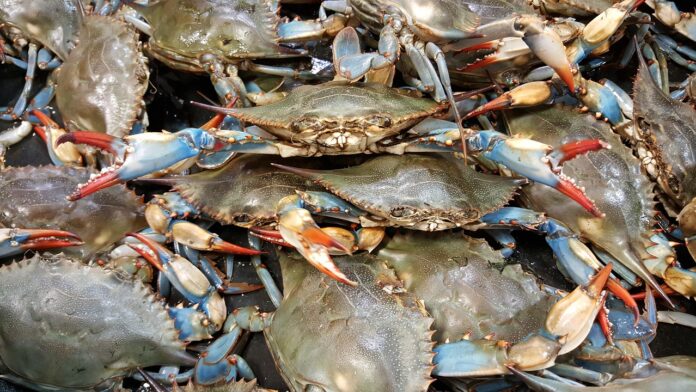The commercial harvest of blue crabs has been extended in Virginia as the crab population trends upward
The Virginia Marine Resources Commission voted last week to approve the extension recommended by the Crab Management Advisory Committee. The harvest of crabs by hard crab pot is now Dec. 16, pushed back from Nov. 30. Lower bushel limits will begin Nov. 1 instead of Oct. 1.
The purpose of these changes is to promote efficient utilization of blue crabs and economic stability for the fishing industry, according to the Marine Resources Commission.
“Female crabs are not overfished and overfishing is not occurring on them,” said Alexa Galván, a fisheries manager with the commission during a VRMC meeting. “But, the 2021 and 2022 exploitation rates were slightly above the target, not of the threshold which would be overfishing.”
Blue Crab Vulnerability
The blue crab is an iconic part of the Chesapeake Bay, commercially and culturally. Their harvest brings in tens of millions of pounds of crab annually.
The Chesapeake Bay is home to hundreds of millions of blue crabs, according to a yearly survey by the Virginia Institute of Marine Science and the Fisheries Service of the Maryland Department of Natural Resources. The first 1990 survey reported 791 million crabs. There were 323 million reported this year.
The Bay’s blue crab population had been on a four-year decline before this year. The crabs were at their lowest population in 33 years in 2022, according to the survey.
The recent 42% increase prompted state agencies to expand commercial fishing timelines.
Blue crabs haven’t been overfished since 2008, when a framework was put in place to protect female crabs, according to Mandy Bromilow. Bromilow is a fisheries specialist at the National Oceanic and Atmospheric Administration.
“Blue crabs are a short-lived species and high natural variability in the population is not uncommon,” Bromilow stated.
The population continues to show some signs of stress, according to Chris Moore, senior regional ecosystem specialist for the Chesapeake Bay Foundation. The target level for adult female crabs is about 200 million and currently sits at about 150 million. The crab population has started to get healthier but concern from marine specialists remains.
Crabs have a sensitivity to various factors
Areas of water with low oxygen, known as dead zones, could take away habitats and food sources from the blue crabs, according to Moore. The dead zones have gotten smaller, but environmentalists are also focused on improving other factors such as water quality and the underwater grass areas where crabs hide and feed.
Crabs are affected by “everything,” including weather. It can be hard to pinpoint why the population is up or down in any given year, according to Moore.
“Our weather affects how many blue crabs actually come into the mouth of the Bay each year and then obviously migrate throughout the rest of the Bay,” Moore said.
Crabs perish in really cold temperatures, but milder temperatures prevented a “winter kill” in recent years.
“In some ways, blue crabs may be one of the winners from climate change,” Moore said.
Loved in Virginia, not so much in Italy
Blue crabs have made recent headlines in Italy, where they have no natural predators. The new abundance in Italy is considered an invasion, a crisis and a threat to the economy. The Italian government allocated over $3 million to help fight against the overwhelming blue crabs.
Blue crabs have been in Italy for a while, likely because the larvae were transferred on ship ballast water, according to Moore. However, the population has expanded without natural predators or awareness of what to do with the crabs.
The warmer Mediterranean Sea allows blue crabs to dodge winter kill, according to Moore.
“The ones that are over in Italy right now, they’re probably there to stay and hopefully they develop some good fisheries techniques for them and they’re able to add them to the menus,” Moore said.
Virginia would not relocate Italian blue crabs to bolster the Chesapeake Bay population, for concerns of disease. A possible method to increase the population would focus more on controlled cultivation and release of the adults — but the aquaculture method is hard because crabs cannot be packed in, according to Moore.
“We’re continuing to do a lot of work to try to ensure a healthier population,” Moore said. “Everything from making sure we have a well-managed fishery to improving water quality and habitat.”
Seafood Industry
Lower blue crab populations have an economic impact, but so does Virginia’s waning infrastructure to process crab meat. People process crabs by removing the shells and picking out the meat, which is often sold by the pound. The decrease in crab picking infrastructure has probably had more effect on the market of crabs than the actual number of crabs out there, according to Moore.
“Historically, people from the community worked in the picking houses,” Moore said. “We’re very good at picking crab meat.”
A lot of the picking workforce shifted to nonimmigrant workers, through the H-2B program, according to Moore. The H-2B program allows U.S. employers to temporarily hire migrant workers for a limited time to perform nonagricultural labor or services.
It’s been getting harder for people to participate in the program, and also just to find people who know how to pick crabs can “be tough as well,” Moore said.
By Gen York / Capital News Service

